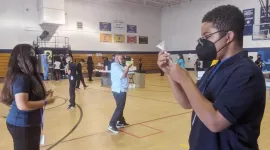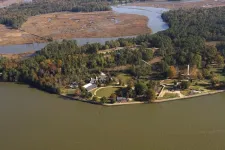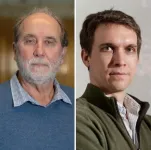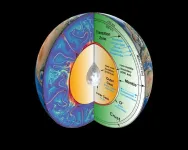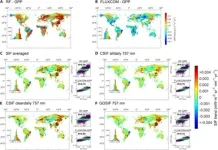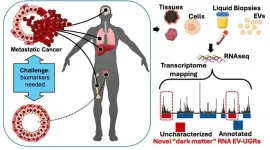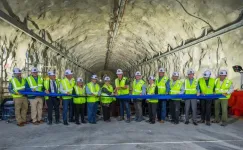(Press-News.org) Two University of Alaska Fairbanks scientists have discovered a new type of “whistler,” an electromagnetic wave that carries a substantial amount of lightning energy to the Earth’s magnetosphere.
The research is published today in Science Advances.
Vikas Sonwalkar, a professor emeritus, and Amani Reddy, an assistant professor, discovered the new type of wave. The wave carries lightning energy, which enters the ionosphere at low latitudes, to the magnetosphere. The energy is reflected upward by the ionosphere’s lower boundary, at about 55 miles altitude, in the opposite hemisphere.
It was previously believed, the authors write, that lightning energy entering the ionosphere at low latitudes remained trapped in the ionosphere and therefore was not reaching the radiation belts. The belts are two layers of charged particles surrounding the planet and held in place by Earth's magnetic field.
“We as a society are dependent on space technology,” Sonwalkar said. “Modern communication and navigation systems, satellites, and spacecraft with astronauts aboard encounter harmful energetic particles of the radiation belts, which can damage electronics and cause cancer.
“Having a better understanding of radiation belts and the variety of electromagnetic waves, including those originating in terrestrial lightning, that impact them is vital for human operations in space,” he said.
Sonwalkar and Reddy’s discovery is a type of whistler wave they call a “specularly reflected whistler.” Whistlers produce a whistling sound when played through a speaker.
Lightning energy entering the ionosphere at higher latitudes reaches the magnetosphere as a different type of whistler called a magnetospherically reflected whistler, which undergoes one or more reflections within the magnetosphere.
The ionosphere is a layer of Earth's upper atmosphere characterized by a high concentration of ions and free electrons. It is ionized by solar radiation and cosmic rays, making it conductive and crucial for radio communication because it reflects and modifies radio waves.
Earth's magnetosphere is a region of space surrounding the planet and created by Earth's magnetic field. It provides a protective barrier that prevents most of the solar wind's particles from reaching the atmosphere and harming life and technology.
Sonwalkar and Reddy’s research shows that both types of whistlers — specularly reflected whistlers and magnetospherically reflected whistlers — coexist in the magnetosphere.
In their research, the authors used plasma wave data from NASA’s Van Allen Probes, which launched in 2012 and operated until 2019, and lightning data from the World Wide Lightning Detection Network.
They developed a wave propagation model that, when considering specularly reflected whistlers, showed the doubling of lightning energy reaching the magnetosphere.
Review of plasma wave data from the Van Allen Probes showed that specularly reflected whistlers are a common magnetospheric phenomenon.
A majority of lightning occurs at the low latitudes, which are tropical and subtropical regions prone to thunderstorm development.
“This implies that specularly reflected whistlers probably carry a greater part of lightning energy to the magnetosphere relative to that carried by magnetospherically reflected whistlers,” Sonwalkar said.
The impact of lightning-generated whistler waves on radiation belt physics and their use in remote sensing of magnetospheric plasma have been researched since the 1950s.
Sonwalkar and Reddy are with the Department of Electrical and Computer Engineering in the UAF College of Engineering and Mines. Reddy is also affiliated with the UAF Geophysical Institute.
Sonwalkar and Reddy’s research is supported by grants from the National Science Foundation and NASA EPSCoR, the Established Program to Stimulate Competitive Research.
CONTACTS:
• Vikas Sonwalkar, University of Alaska Fairbanks vssonwalkar@alaska.edu
• Rod Boyce, University of Alaska Fairbanks Geophysical Institute, 907-474-7185, rcboyce@alaska.edu
END
UAF scientists discover phenomenon impacting Earth’s radiation belts
2024-08-16
ELSE PRESS RELEASES FROM THIS DATE:
New AI tool captures how proteins behave in context
2024-08-16
A fish on land still waves its fins, but the results are markedly different when that fish is in water. Attributed to renowned computer scientist Alan Kay, the analogy is used to illustrate the power of context in illuminating questions under investigation.
In a first for the field of artificial intelligence (AI), a tool called PINNACLE embodies Kay’s insight when it comes to understanding the behavior of proteins in their proper context as determined by the tissues and cells in which these proteins act and ...
Researchers investigate parent perceptions of virtual learning
2024-08-16
In response to the COVID-19 pandemic, a majority of schools across the U.S. shifted to virtual learning. In a new study, published in Social Education Research, researchers conducted interviews with parents of students who attended middle or high schools to understand how virtual learning impacted their daily routines, stress levels, and the academic performance of the children.
The transition to virtual learning necessitated the creation of online lessons in a very short time period and with limited training of teachers. As a result, parents and students had to deal with unexpected changes in their home lives and learning environments.
“Virtual learning will not be limited ...
Ancient DNA reveals Indigenous dog lineages found at Jamestown, Virginia
2024-08-16
Previous scientific studies have indicated that North American dog lineages were replaced with European ones between 1492 and the present day. To better understand the timing of this replacement, researchers from the University of Illinois Urbana-Champaign and the University of Iowa sequenced mitochondrial DNA from archaeological dogs. Their findings suggest a complex social history of dogs during the early colonial period.
Europeans and Native Americans valued their dogs as companion animals, using them for similar work and as symbols of identity. Consequently, ...
Researchers make breakthrough in fight against COVID-19
2024-08-16
A team led by Jose Onuchic at Rice University and Paul Whitford at Northeastern University, both researchers at the National Science Foundation Physics Frontiers Center at the Center for Theoretical Biological Physics (CTBP) at Rice, has made a discovery in the fight against severe acute respiratory syndrome coronavirus-2 (SARS-CoV-2), the virus responsible for COVID-19.
The team, in partnership with an experimental effort led by Yale University researchers Walter Mothes and Wenwei Li, has uncovered new insights into how the virus infects human cells and how it can be neutralized. Their findings were published in the ...
Methamphetamine-involved psychiatric hospitalizations have increased, study says
2024-08-16
AURORA, Colo. (August 16, 2024) – A new study, out now in Drug and Alcohol Dependence, that details trends among psychiatric hospitalizations between 2015-2019 finds that while most hospitalizations did not involve any substances, methamphetamine-related hospitalizations have increased while overall number of psychiatric hospitalizations remained stable.
Additionally, researchers detail that psychiatric hospitalizations caused by methamphetamine use were highest in the Mountain West region but were also shifting geographically. “Rates of ...
Green warriors: plants on the frontline against microplastics
2024-08-16
In an innovative ecological article, researchers have unveiled the potential of phytoremediation to curb microplastic pollution. This approach leverages natural plant processes to absorb and diminish micro and nanoplastics, offering a viable solution for managing environmental plastic pollution. This viewpoint advocates utilizing plant life as an effective tool against the widespread issue of plastic contamination in ecosystems.
With escalating concerns about the enduring impact of plastic waste, phytoremediation emerges as a promising solution. This method utilizes plants ...
Decoding mysterious seismic signals
2024-08-16
For the decades since their discovery, seismic signals known as PKP precursors have challenged scientists. Regions of Earth’s lower mantle scatter incoming seismic waves, which return to the surface as PKP waves at differing speeds.
The origin the precursor signals, which arrive ahead of the main seismic waves that travel through Earth’s core, has remained unclear, but research led by University of Utah geophysicists sheds new light on this mysterious seismic energy.
PKP precursors appear to propagate from places deep below North America and the western Pacific and possibly bear an association with “ultra-low velocity zones,” thin layers ...
Green light for accurate vegetation research: new evaluation of global SIF datasets
2024-08-16
A recent study has pinpointed the top-performing solar-induced chlorophyll fluorescence (SIF) products for precise global monitoring of photosynthesis and vegetation dynamics. By thoroughly evaluating eight widely-used SIF datasets, the research team identified Global OCO-2 SIF (GOSIF) and Contiguous Solar-Induced Fluorescence (CSIF) as leading tools for estimating gross primary productivity (GPP) and forecasting key phenological stages. These findings provide crucial direction for scientists aiming to enhance global vegetation ...
Mount Sinai researchers discover novel nanoparticles in blood with potential to transform cancer diagnosis
2024-08-16
New York, NY [August 16, 2024]—Scientists at the Icahn School of Medicine at Mount Sinai have identified a new class of RNAs packed into tiny particles known as extracellular vesicles (EVs) that could revolutionize how cancer and other diseases are diagnosed. The team found that these molecules undergo changes when cancer is present, suggesting their potential as biomarkers for detecting prostate cancer or as targets for therapy. The work, led by Navneet Dogra, PhD, Edgar Gonzalez-Kozlova, PhD, Tzu-Yi Chen, PhD, ...
Underground event marks excavation completion on colossal caverns for underground neutrino laboratory, DUNE
2024-08-16
Lead, SD (Aug. 15, 2024) — A ribbon-cutting event was held today at the Sanford Underground Research Facility (SURF) in Lead, S.D. to mark the completion of excavation work for the Long-Baseline Neutrino Facility/Deep Underground Neutrino Experiment (LBNF/DUNE), an international project led by the U.S. Department of Energy’s Fermi National Accelerator Laboratory. The “Into the Depths of Discovery” event, hosted by Fermilab and the South Dakota Science and Technology Authority (SDSTA), was attended by supporters of the three-year excavation of the caverns, including state and federal leaders as well as officials from the Department of Energy.
“Today ...
